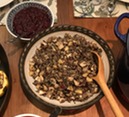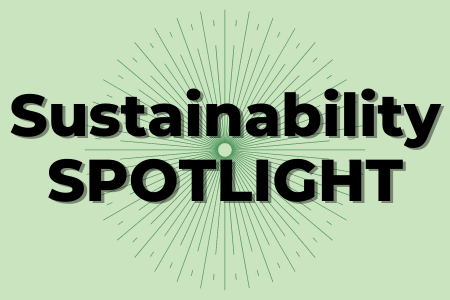 This adapted recipe from Sean Sherman beautifully fills the bill for an autumnal main dish, with a satisfying weight and a harmonious blend of colors, flavors, and textures. Yield: 4 servings
Cook 1/2 cup dried hominy and 1/2 cup dried beans by your preferred method. The recommended bean is brown tepary; other options include cranberry, pinto, or black. Drain and reserve about 1 cup of cooking liquid.
Take 1 small acorn squash (about 1¼ pounds), halved, seeds and membranes scraped away, cut into 1-inch chunks. Toss it in 1 tablespoon sunflower oil and a pinch of coarse sea salt. Arrange the squash in an even layer on a parchment-lined baking sheet and roast in a 425 degree oven until golden and very tender, stirring halfway through, 35 to 45 minutes.
In a large skillet, heat the remaining 2 tablespoons oil over medium-high. Add
-
1 small yellow onion, halved and thinly sliced
-
1 tablespoon New Mexico Hatch chile powder or any mild smoked red chile powder
-
2 teaspoons chopped fresh sage
- and a generous pinch of smoked salt and cook, stirring occasionally, until the onions are tender, 5 to 8 minutes.
Add the reserved bean cooking liquid and bring to a simmer.
Add the cooked hominy and beans to the skillet, then stir in the roasted squash and ½ cup chopped dark greens, such as dandelion greens, kale or spinach. Season to taste with coarse sea salt and serve.

Another recipe from Sean Sherman offers nutty, chewy goodness!
Bring 5 cups water to a boil. Stir in 1 cup wild rice along with ½ cup mixed dried berries (any combination of cranberries, blueberries or sour cherries) and 3 tablespoons maple syrup. Once the mixture comes back to a boil, reduce the heat so the liquid is just simmering, cover and cook until the grains begin to open, 20 to 40 minutes, checking doneness after about 20 minutes. The rice is done when it has opened slightly, is tender and has quadrupled in size. Drain.
Arrange ¼ cup whole hazelnuts in a single layer on a baking sheet and toast them in a 350 degree oven until the skin blisters and cracks and they begin to smell nutty, 10 to 12 minutes. Transfer the nuts to a clean dish towel and massage them aggressively to remove most of the skins. Crush the nuts directly in the towel using the flat side of a knife or the bottom of a small, heavy frying pan.
Add another ¼ cup rice to a dry medium skillet and cook the rice over high heat, shaking the pan, until it begins to darken and about half of the kernels have popped, 2 to 3 minutes. Remove from the heat.
Drizzle the boiled rice with 2 tablespoons hazelnut oil and season to taste with salt. Divide among bowls and garnish with the popped rice, hazelnuts and bias-cut chives or scallions.
|

This recipe from Melissa Clark gets its depth from soy sauce and caramelized mushrooms. In a large skillet, heat ½ cup extra-virgin olive oil over medium-high heat. Add ½ cup finely chopped onion and 1 cup finely chopped mushrooms. Cook, stirring, until well browned, 8 to 10 minutes. Sprinkle in ½ cup all-purpose flour and cook, stirring, until golden brown, 3 to 5 minutes. Slowly whisk in 4 to 5 cups vegetable stock, a little at a time, until a smooth sauce forms. Simmer 2 to 3 minutes until thickened. Season with 1 teaspoon soy sauce, salt and pepper. Serve as is, or pass it through a fine mesh strainer.
|
 Elizabeth Wagner
Table to Table Operations Coordinator
 How do you take climate action?
My favorite way to take climate action is at Table to Table! Every day I am able to witness and be a part of a mission to keep perfectly wholesome food out of our waste streams and into our community. Outside of work, I take climate action by having climate conversations with friends and family, shopping locally, voting, contacting my elected officials, and educating myself on social, environmental, and food justice.
Why is climate action important to you?
Climate action is important to me because it is about more than just protecting our future and planet, but also ensuring justice and equity for our communities. Climate issues are rooted in racial, economic, and environmental injustice, and cannot be solved without centering and listening to those most impacted by climate change. By taking climate action through a justice-centered approach, we can create solutions that are inclusive, equitable, and sustainable.
What can others do to take climate action?
Get involved with local community groups! There are many awesome organizations doing climate and social justice work in our community that you can support, and there are endless ways to do so. If you enjoy biking, you can participate in the annual “Cranksgiving” on Sunday, Nov. 17: a part bike ride, part food drive event where attendees will bike to local stores and purchase food to donate to Table to Table and CommUnity Food Bank! Volunteering with Table to Table is also pretty cool - you can help fight food waste and food insecurity by rescuing wholesome food and distributing it throughout our community!
|